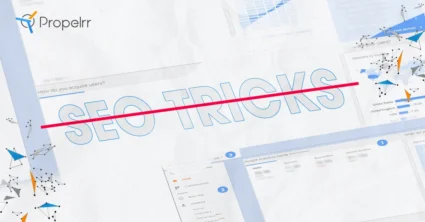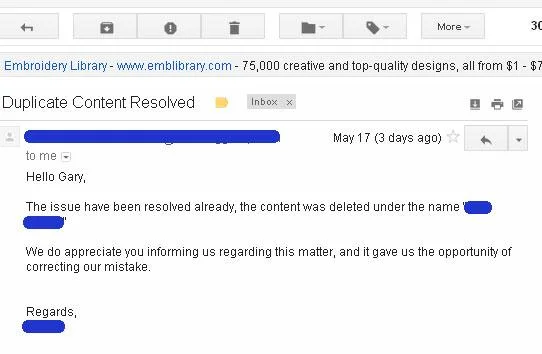How to Combat Dirty SEO Tricks Damaging Your Efforts
Author & Editor
Founder & CEO
Published on: Nov 29, 2022 Updated on: May 21, 2024

Table of Contents
Whenever we notice unusual link activity on our client’s websites, we at immediately investigate what or who causes a sudden surge of links. And, to no one’s surprise, the culprit is always revealed by Google Alerts.
And often, they are spammy sites that link to the websites uninvitedly.
The situation went like this:
- Our client’s website was linked to free site directories which, we all know, Google has been penalizing and dropping lately from their database.
- Moreover, we were also getting links using an underscore character (“_”) anchor text inserted within the duplicate articles.
Cases that are dubious, considering that we keep stock of all our ethical link-building efforts.
Given the scenario, we thought of two possible sources for the dubious rise in spammy links. These are:
- Our client’s website and the owner of those author bio links were the target of black hat SEO tactics, and;
- The owners of author bio links are the ones doing the SEO activity.
Addressing the issue
Looking into the websites uncovered in our link analysis, we found that most of the links were owned by a reputable multinational company. This organization may have hired an SEO or a link builder doing low quality works with or without the knowledge of the company.
This posed a problem because the negative links were pulling down the client’s website performance. Our white hat SEO efforts were, needless to say, nullified.
With that, we needed to act fast in addressing the matter. And of the options we had for taking action, we of course went with the easier more amicable route.
Here’s what we did:
1. We got their number and made a call.
We let them know that we are an SEO company working for their competition and that we noticed an unnatural link building activity regarding their website that may put them in trouble.
However; the person we talked to told us that the one responsible for their SEO activity was not around so they will just call back.
Based on the phone conversation, it was obvious that they have an in-house SEO. One question, answered.
2. We emailed their catch-all address found on their website.
Given the urgency of the situation, we did not wait for them to call us back, we emailed them. We thought of using their catch-all email address to alert every concerned personnel or stakeholder of the company so that they can immediately address the mistake committed.
Now, this is where our friendly strategy comes in. We intentionally crafted our email to show our concern to their brand and let them know that they may be a victim of dubious SEO activity. You may read our email below.

After a day, we received an email from the concerned company coming from their in-house SEO. Read below.

We followed it up with a series of emails pointing out more links and URLs until all were removed and cleaned by their in-house SEO.
Our learnings from the situation
1. Never forget to set up tools monitoring your website and constantly check the incoming links/alerts.
Believe it or not, it is our Google Alerts setup among all the tools that we are using that led us to detect the said activity.

However; there are a lot of best backlinks checker tools you can use that we also have been using in the company as follows:
2. Alert all Stakeholders of the erring company about the said activity by showing concern for their brand and reach out.
I find this really effective to immediately move their butts addressing the problem. I believe every sane manager from a reputable company would not want to blow their brand equity.
In most cases, such bad activity is being caused by unmonitored staff who wanted to make their work life easier by regressing to not-so-good tactics. So, a wake-up call/email does the trick.
3. Unnatural activity should be addressed with utmost importance but do it amicably.
There is no better approach than being cordial to get across your message. We mean this in every way.
When we called and email them because we are aware that they may deny the result of our investigation. It is a normal defensive reaction, right? That is why we showed our concern for their brand.
Actually, one may reason out a la Napaleon Bonaparte saying, “Never interrupt your enemy when he is making a mistake.”
However; the twist here is that we were inadvertently (?) linked to those duplicate content on free article directories! Thus, we had no recourse but to get them to remove those spammy links.
4. Build a good relationship with the involved party.
Each and every SEO practitioner out there started at a certain point where they get stuck in the dark. This is the case maybe with the in-house SEO we caught red handed.
Their apology and due acknowledgment of the mistake was good enough for us. Maybe someday, they may send us some link love and give us a referral from a highly authoritative site. Or they could even alert us of other possible attacks that we may not be aware of.
5. Hire a really skilled SEO practitioner.
There are interesting articles on how to ferret out good SEOs from the bad ones.
You may refer to the following posts below:
- Ian Lurie’s How To Hire An SEO Company 2012 edition.
- Richard Baxter’s How to Recruit an SEO.
6. When all else fails, keep building your client’s websites without resorting to low-quality link-building methods.
We do believe that a continuous build-up of your clients’ brands the right way will provide you better leverage against potential attacks (intentional or unintentional).
Investing in content marketing
Toby Murdock wrote an informative post on building and operating a content marketing machine that we believe you need to check out.
Content marketing as a subject is ubiquitous among marketing professionals both digital and traditional. It is nothing new but it works big time.
The case of Ross Hudgens
To set an example about content marketing, Ross Hudgens has proven that good content and self-less sharing of know-how on link building strategies catapulted him to be recognized by influencers and eventually became an influencer himself in the search industry.
It is a matter of building compelling content, reaching out to influencers, syndicating your content and “being present” during good conversations can spell the difference between failure and success.
Admittedly, we first learned about Ross at Moz blog writing about search engine optimization and not via his own blog site. Cleverly, he managed to build “linkable assets” using his many ideas on link building techniques at the right place where a lot of search industry influencers are hanging out (SEOMoz) until he was able to leverage such exposure driving folks to his own blog.
Indeed, he knows what he is doing in building his own personal brand. We think it is a good example of excellent content marketing at work.
Certainly, there is a good list of people in the space of link building where Ross dwells but they all have one thing in common that is, they all know how to pull off content marketing concepts rightly.
The case of WordStream
Another excellent case study on content marketing is WordStream’s recent research on Facebook Advertising and Goole Ads Network Comparison which earned a huge amount of citations, mentions and links as evidenced by the post of Larry Kim, Founder of WordStream entitled, “Opps, I ruined the Facebook IPO!“.
Now, angling that to the brands that you handle, invest in high quality content marketing strategy and you will never go wrong. It will even protect your clients against bad reps and possible intentional outings.
This may not be a silver bullet to solve those dirty tactics that may be thrown against them but surely, it will help augment their brand authority and overshadow negative works against them.
